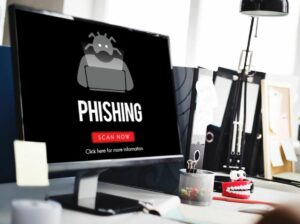Have you ever received a fake bank email threatening to freeze your checking account unless you confirm your personal information? There could have been a link in the email. And if you did? It’s possible that you visited a website that required you to enter personal data like your Social Security number and bank account details.
The issue? Your actual bank has never sent you one of these emails. Instead, they’re a component of the phishing scamming tool used by fraudsters, endangering your cybersecurity.
Please read: ELECTRONIC – KNOW YOUR CUSTOMER (EKYC)
How Phishing Works
Typically, you’ll get an email that purports to be from a respected firm you know and deal with, like your financial institution. In some instances, the email may appear to be from a government organization, such as one of the federal authorities in charge of regulating financial institutions.
You’ll likely receive an email alerting you to a significant issue that needs your quick action. The email will then persuade you to click on a button to connect to the institution’s Website by using language like “Immediate attention required,” or “Please contact us immediately about your account.”
You might be taken to a fake email or website that looks exactly like the real one in a phishing scam. In some cases, it can even be the company’s official website. In some circumstances, a pop-up window will emerge immediately to get your financial information.
Your Social Security number, account number, password, or the details you use to prove your identity when speaking to a real financial institution, such as your mother’s maiden name or place of birth, may be requested in either scenario. You may also be asked to update your account information.
You can become a victim of identity theft if you give the necessary information. Here are 10 basic guidelines for keeping yourself safe:
Educate Yourself on Phishing Techniques
Every day, new phishing scams are created. If you don’t keep up with these emerging phishing scams, you can unintentionally become a victim of one. Keep an eye out for updates on fresh phishing scams. You will have a considerably reduced chance of falling victim to one if you learn as much as you can about them in the beginning.
Continuous security awareness training and simulated phishing for all users are highly advised for IT administrators to keep security at the forefront of the firm.
Think Before You Click!
Clicking links on reputable websites is acceptable. However, it’s not a good idea to click on links that appear in random emails and instant chats. Before clicking on any links you are unsure of, hover over them. Do they take the appropriate leadership positions?
When you click the link in a phishing email to visit the website, it can look just like the real website. The email may claim that it is from a reliable company.
Even if the email might urge you to fill out the form, your name might not be included.
Install an Anti-Phishing Toolbar
Anti-phishing toolbars can be added to the majority of widely used Internet browsers. These toolbars quickly scan the websites you are visiting and contrast them with databases of well-known phishing sites. The toolbar will warn you if you land on a dangerous website. This additional measure of defense against phishing fraud is free.
Check the Security of a Site
It’s only natural to feel a little hesitant when providing private financial information online. However, as long as you are on a secure website, you shouldn’t encounter any issues. Make sure the site’s URL starts with “https” and that a closed lock icon is present near the address bar before entering any information.
Additionally, look for the site’s security certificate. Do not open a website if you receive a warning that it may contain harmful files. Never download files from emails or websites you are unsure of.
Even search engines occasionally display links that could take viewers to a phishing website selling cheap goods. Cybercriminals will gain access to credit card information if the user makes purchases on such a website.
Be Wary of Pop-Ups
Pop-up windows frequently impersonate useful elements of websites. However, they are phishing efforts all too frequently. Pop-ups can be blocked in many popular browsers, and you can choose to enable them in specific situations.
Don’t click the “cancel” button if you do manage to get through the cracks; these buttons frequently take you to phishing websites. Instead, click the tiny “x” in the window’s upper corner.
Employ firewalls
Superior firewalls serve as barriers between your computer and outside invaders and you. A desktop firewall and a network firewall are the two types you should utilize. A type of hardware is represented by the second option and a type of software by the first.
Together, they greatly minimize the likelihood that hackers and phishers will get access to your computer or network.
Keep Your Browser Up to Date
Popular browsers frequently receive security updates. They are made public in response to the security flaws that hackers and other cybercriminals inevitably find and use. If you usually disregard alerts to update your browsers, stop. Download and install any updates as soon as they become available.
Never Disclose Personal Information
In general, you should never disclose confidential financial information online. This restriction dates back to the era of Filipino Online when consumers were continually forewarned due to the early phishing scams’ popularity. When in doubt, go to the company’s official website, find their phone number, and give them a call.
The majority of phishing emails will send you to pages where you must enter personal or financial information. The links in the emails should never be used by Internet users to enter confidential information.
Never email someone with private information in it. Make it a habit to look up the website’s address. Every secure website begins with “https”.
How to recover after responding to a phishing email?
What if you were the victim of an email scam? Maybe you clicked on a link that let malware into your machine or sent financial information to a scammer.
You should move rapidly. Here are some actions you may take to help prevent identity theft if you have reacted to a phishing scam.
- Make a new password.
- Make the credit bureaus aware.
- Get in touch with your credit card issuers.
- Investigate your credit reports.
- Examine the credit card statements you have.
Please read: HOW DO I REPORT AN UNAUTHORIZED TRANSACTION?
Conclusion
The simplest way to protect your data privacy from phishing scams is to educate yourself/ members about how they work and what to look out for. With frequent awareness training, you will be able to recognize phishing efforts even as they get more sophisticated.
Until you continually reinforce the advice on preventing fraud, your workers won’t be able to develop good habits or perceive negative messaging as instinctively necessary.





